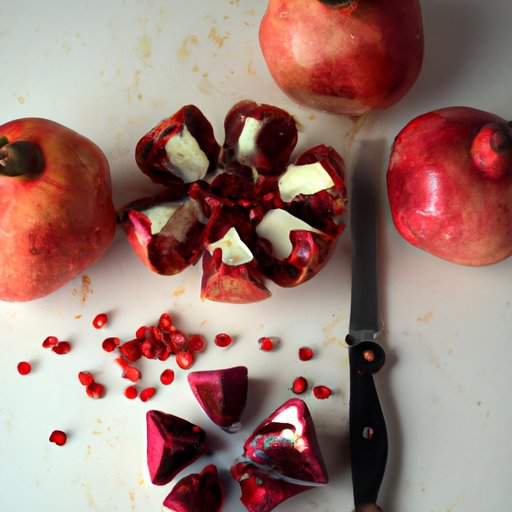I. Introduction
Peeling a pomegranate can be a daunting task for many people. The tough outer layer and juicy, seed-filled interior can make it difficult to handle and peel. However, with the right knowledge and tools, peeling a pomegranate can be a stress-free task that yields healthy, delicious seeds. In this article, we will provide a step-by-step guide to peeling a pomegranate, as well as tips, tricks, tools, and health benefits associated with this superfood.
II. A Step-by-Step Guide to Peeling a Pomegranate
1. Begin by cutting off the crown of the pomegranate. This is the small, pointed end of the fruit where the stem is located.
2. Use a sharp knife to make 4-6 shallow cuts around the exterior of the pomegranate, from top to bottom.
3. Submerge the pomegranate in a bowl of cold water and soak for 5-10 minutes. This will allow the fruit to become softer and easier to peel.
4. Use your hands to gently break apart the pomegranate under the water. This will help release the seeds from the membrane.
5. Use your fingers to remove any remaining membrane from the seeds.
6. Pour the water and seeds in a colander to separate the seeds from the water.
7. Rinse the seeds in cold water and drain in the colander.
Tips:
– Wear an apron or old clothes, as the pomegranate juice can stain.
– Place the bowl in the sink to avoid making a mess.
– Be patient and take your time when removing the membrane to avoid squishing the seeds.
III. Pomegranate Peeling Shortcuts
Peeling a pomegranate can take time and effort, but there are some shortcuts that can make the process faster and more efficient.
– Cut off the crown and lightly score the pomegranate, as in step 2 of the traditional method, but instead of submerging the fruit in water, use a wooden spoon to gently tap the back of the fruit. The seeds will fall out more easily.
– Cut the pomegranate in half and use a spoon to scoop out the seeds, similar to an avocado. This method may not preserve the seeds as well as the traditional method but is an easy option for those in a hurry.
IV. Pomegranate Peeling Tools
There are several tools available that can help make peeling pomegranates easier and more efficient.
– Pomegranate deseeder: This tool is specially designed to easily and efficiently deseed pomegranates.
– Wooden spoon: Use a wooden spoon to tap the back of the pomegranate, as in the shortcut method described above.
– Bowl of water: Submerging the pomegranate in a bowl of water can make it easier to peel and prevent stains.
V. The Health Benefits of Pomegranates
Pomegranates are not only delicious but are also packed with nutrients that are good for your health. Some of the benefits of consuming pomegranates are:
– Rich in antioxidants, which can reduce inflammation and protect against chronic diseases such as heart disease and cancer.
– Lowers blood pressure and reduces the risk of heart disease.
– May help reduce joint pain and arthritis symptoms.
Looking for ways to add more pomegranate to your diet? Try adding the seeds to smoothies, yogurt, salads, or grain bowls.
VI. Pomegranate Recipes and Peeling Techniques
Some delicious recipes that use pomegranates are:
– Pomegranate salsa: Mix diced pomegranate seeds with diced tomatoes, onions, cilantro, lime juice, and salt for a fresh and flavorful dip or topping.
– Pomegranate guacamole: Add pomegranate seeds to the classic guacamole recipe for a sweet and tangy twist.
– Pomegranate and feta salad: Toss fresh greens with pomegranate seeds, feta cheese, and a simple dressing for a light and refreshing salad.
VII. Pomegranate Peeling Mistakes to Avoid
Some common mistakes that people make when peeling pomegranates are:
– Cutting too deep into the pomegranate, which can damage the seeds.
– Not soaking the pomegranate in water, which can make it more difficult to peel.
– Rushing the process and not being patient when removing the membrane, which can cause the seeds to squish.
VIII. The History and Cultural Significance of Pomegranates
Throughout history, pomegranates have been considered a symbol of fertility, abundance, and rebirth in various cultures around the world, including Ancient Greece, Rome, Judaism, and Christianity. In some cultures, pomegranates are even used in ritual and religious ceremonies, such as the Jewish New Year and Catholic Christmas celebrations. The various cultural significances of the pomegranate can also impact the way it is traditionally peeled and consumed. For example, in certain Middle Eastern cultures, pomegranates are peeled and eaten with a spoon.
IX. Conclusion
Knowing how to properly peel a pomegranate can make this superfood a healthy and delicious addition to your diet. Whether you use the traditional method or one of the shortcuts or tools, taking your time and being patient is key to producing the best results. With this guide, tips, and tricks, you are now equipped to peel pomegranates like a pro.
